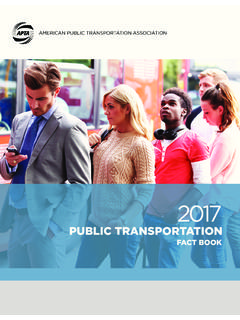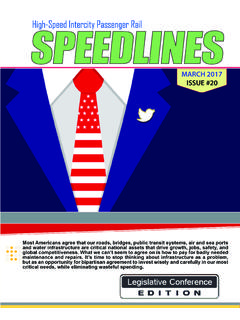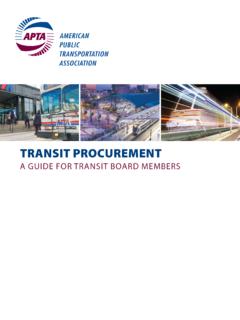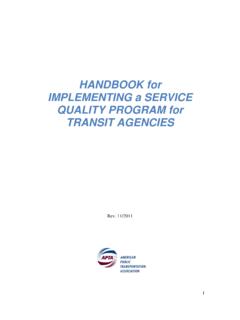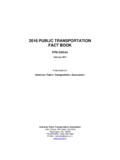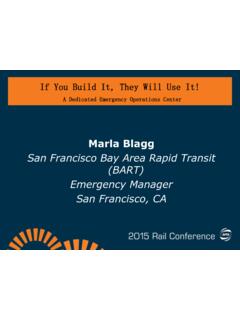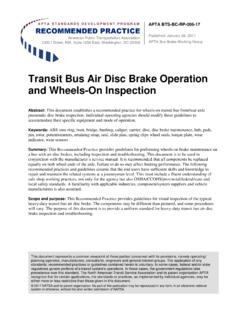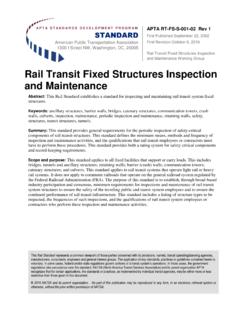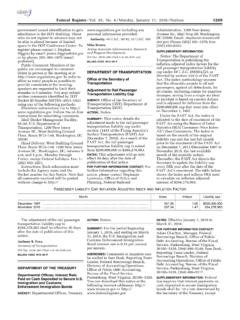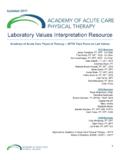Transcription of Rail Transit Accident/Incident Investigation
1 apta STANDARDS DEVELOPMENT PROGRAM. apta RT-OP-S-002-02 Rev 2. RAIL STANDARD First Revision July 26, 2004. american public transportation association Second Revision March 31, 2012. 1666 K Street, NW, Washington, DC, 20006-1215 apta Rail Transit Standards Operating Practices Committee Rail Transit Accident/Incident Investigation Abstract: This standard provides a common framework for rail Transit systems to develop Accident/Incident Investigation plans. Additional recommendations on how rail Transit systems should implement the policies and procedures contained in the plan required by this standard are given in the informative Annex A, Recommended Process for Performing Rail Transit Accident/Incident Investigations. Keywords: accident, incident, Investigation , notification, reporting Summary: This standard describes requirements that a rail Transit system (RTS) shall develop and implement for Accident/Incident Investigation plans.
2 The standard requires that the RTS Accident/Incident Investigation plan address policies and procedures; notification and reporting; Investigation thresholds; coordination with government and regulatory agencies; formal Investigation process; training; and post-accident reporting. The requirements that a RTS shall follow to develop its Accident/Incident Investigation plan are provided in the main body text of this standard. Individual rail Transit systems shall apply this standard as it relates to that RTS's organizational structure and operating environment. Recommendations for the process (a system or set of procedures) the RTS should follow to perform Accident/Incident investigations are given in Annex A. Annex A does not contain additional requirements. Scope and purpose: This standard is intended to assist RTS personnel in investigating accidents/incidents in a logical and organized manner.
3 Since each Accident/Incident may be different, the procedures and steps described in this document will not necessarily be applied to, nor required for, every RTS Accident/Incident Investigation . The purpose of Accident/Incident Investigation is to gather and assess facts in order to determine cause(s); and to identify corrective measures to prevent recurrence. Accident/Incident Investigation is not intended to affix blame, or subject people to liability for their actions, or to recommend disciplinary action. The purpose of this standard is to help rail Transit systems obtain Accident/Incident Investigation results to learn more about mechanical and other failures and human factors and to correct unsafe conditions. This Rail Standard represents a common viewpoint of those parties concerned with its provisions, namely, Transit operating/planning agencies, manufacturers, consultants, engineers and general interest groups.
4 The application of any standards, practices or guidelines contained herein is voluntary. In some cases, federal and/or state regulations govern portions of a Transit system's operations. In those cases, the government regulations take precedence over this standard. apta recognizes that for certain applications, the standards or practices, as implemented by individual Transit agencies, may be either more or less restrictive than those given in this document. 2012 american public transportation association . No part of this publication may be reproduced in any form, in an electronic retrieval system or otherwise, without the prior written permission of the american public transportation association . Contents Introduction .. ii Participants Note on alternate practices .. iii The american public transportation association greatly appreciates the contributions of Russell Stone, David Wright, 1.
5 Accident/Incident Investigation 1 Michael Avery who provided the primary effort Policies and procedures .. 1 in revising this Rail Standard. Investigation thresholds .. 1 At the time this standard was completed, the Notification .. 1 apta Rail Transit Standards Operating Coordination with government or regulatory agencies .. 3 Practices Committee included the following Investigation process .. 3 members: Training .. 3 Charles Dziduch, Chair Duane Sayers, First Vice Chair Post-accident reporting .. 3 David Murphy, Second Vice Chair Ray Abraham Theresa Impastato 2. References .. 4 Tony Abdulla Reginald Mason Roy Aguilera Pat McBride 3. 4 Michael Avery Harry McCall William Bell Pamela McCombe Bill Capps Mark Miller 4. Abbreviations and acronyms .. 5 Rudy Crespo Terry Mulcahy Brian Dwyer Charles Dziduch Troy McLaughlin Dan Murphy (CTA).
6 Annex A (Informative): Recommended process for performing rail Transit Alfred Fazio David Murphy (CATS) Accident/Incident 6 Gaynard Griffiths David Murphy (NYCT) Overview .. 6 Larry Gaul Amanda Nightingale Scott Grott Duane Sayers Initiation of Investigation .. 6 Richard Hanratty Russell Stone Initial RTS response .. 6 Melvin Henry John Squitieri Accident/Incident on-site data development .. 7 Gary Howard Tom Tupta John Humphrey Denis Van Dyke Accident/Incident off-site data 10 Paul Jamieson John Weber Analysis .. 14 Jim Kelly David Wright Lynetta Leeds Preparing reports and recommendations .. 15 Stephen Lino Follow-up .. 16 Project consultants Operations Coordination .. 16 Kenneth A. Korach transportation Resource Associates, Inc. Christopher Wallgren transportation Resource Associates, Inc.
7 Project team Charles Joseph american public transportation association 2012 american public transportation association | ii Introduction (This introduction is not a part of apta RT-OP-S-002-02 Rev 2, Standard for Rail Transit Accident/Incident Investigation ). This Standard for Rail Transit Accident/Incident Investigation represents a common minimum framework for those parties concerned with its provisions, namely, Transit operating/planning agencies, manufacturers, con- sultants, engineers and general interest groups. In some cases, Federal and/or State regulations govern por- tions of a Rail Transit System's (RTS) operations. In those cases, the government regulations take prece- dence over this standard. apta recognizes that for certain applications, the standards or practices, as imple- mented by an individual RTS may be either more or less restrictive than those given in this document.
8 This standard is intended to assist RTS personnel in investigating accidents/incidents in a logical and orga- nized manner. Since each Accident/Incident may be different, the procedures and steps described in this doc- ument will not necessarily be applied to, nor required for, every RTS Accident/Incident Investigation . Note on alternate practices Individual rail Transit systems may modify the practices in this standard to accommodate their specific equipment and mode of operation. apta recognizes that some rail Transit systems may have unique operating environments that make strict compliance with every provision of this standard impossible. As a result, certain rail Transit systems may need to implement the standards and practices herein in ways that are more or less restrictive than this document prescribes.
9 An RTS may develop alternates to the apta standards so long as the alternates are based on a safe operating history and are described and documented in the system's safety program plan (or another document that is referenced in the system safety program plan). Documentation of alternate practices shall: Identify the specific apta rail Transit safety standard requirements that cannot be met;. State why each of these requirements cannot be met;. Describe the alternate methods used; and Describe and substantiate how the alternate methods do not compromise safety and provide a level of safety equivalent to the practices in the apta safety standard (operating histories or hazard analysis findings may be used to substantiate this claim). 2012 american public transportation association | iii apta RT-OP-S-002-02 Rev 2 | Rail Transit Accident/Incident Investigation Rail Transit Accident/Incident Investigation & Notification 1.
10 Accident/Incident Investigation requirements Policies and procedures The RTS shall develop formal policies and procedures for performing Accident/Incident investigations. These policies and procedures shall be implemented whenever the Investigation threshold set by the RTS in Section is met or exceeded. Recommendations on how to implement these policies and procedures are given in informative Annex A. Investigation thresholds The RTS shall set internal thresholds that trigger the need for a formal Accident/Incident Investigation . Mandated federal Accident/Incident notification thresholds that may be used by the RTS to trigger an internal, independent Investigation are detailed in Section of this standard. However, the RTS is free to set any thresholds that do not conflict with federal or local laws or regulations.
